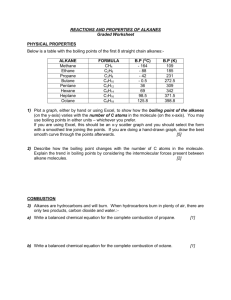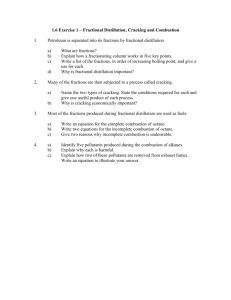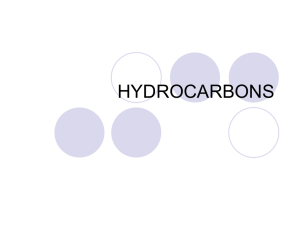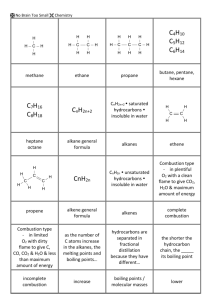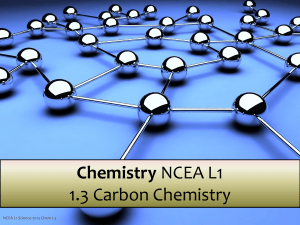100KB - NZQA
advertisement
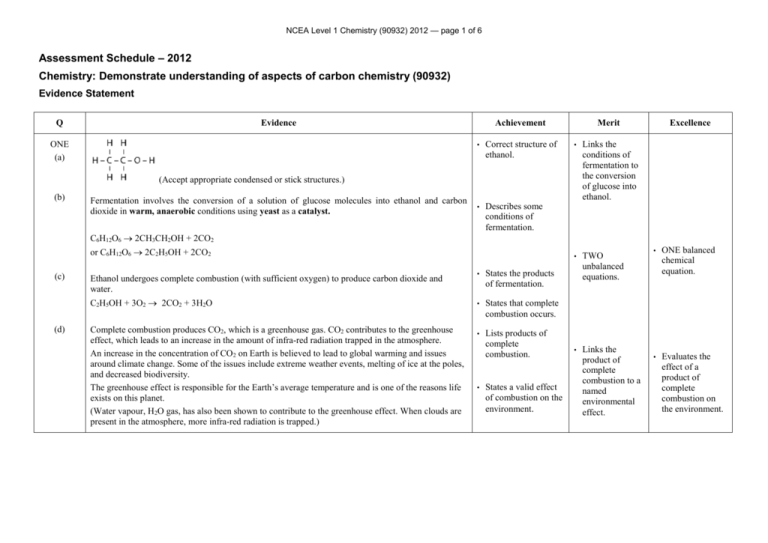
NCEA Level 1 Chemistry (90932) 2012 — page 1 of 6 Assessment Schedule – 2012 Chemistry: Demonstrate understanding of aspects of carbon chemistry (90932) Evidence Statement Q Evidence ONE (a) Achievement • Correct structure of ethanol. • Describes some conditions of fermentation. Merit • Links the conditions of fermentation to the conversion of glucose into ethanol. • TWO unbalanced equations. • Links the product of complete combustion to a named environmental effect. (Accept appropriate condensed or stick structures.) (b) Fermentation involves the conversion of a solution of glucose molecules into ethanol and carbon dioxide in warm, anaerobic conditions using yeast as a catalyst. Excellence C6H12O6 2CH3CH2OH + 2CO2 or C6H12O6 2C2H5OH + 2CO2 (c) (d) • States the products of fermentation. C2H5OH + 3O2 2CO2 + 3H2O • States that complete combustion occurs. Complete combustion produces CO2, which is a greenhouse gas. CO2 contributes to the greenhouse effect, which leads to an increase in the amount of infra-red radiation trapped in the atmosphere. An increase in the concentration of CO2 on Earth is believed to lead to global warming and issues around climate change. Some of the issues include extreme weather events, melting of ice at the poles, and decreased biodiversity. The greenhouse effect is responsible for the Earth’s average temperature and is one of the reasons life exists on this planet. (Water vapour, H2O gas, has also been shown to contribute to the greenhouse effect. When clouds are present in the atmosphere, more infra-red radiation is trapped.) • Lists products of complete combustion. Ethanol undergoes complete combustion (with sufficient oxygen) to produce carbon dioxide and water. • States a valid effect of combustion on the environment. • ONE balanced chemical equation. • Evaluates the effect of a product of complete combustion on the environment. NCEA Level 1 Chemistry (90932) 2012 — page 2 of 6 NØ N1 N2 A3 A4 M5 M6 E7 E8 No response or no relevant evidence. 1a 3a 4a 5a 2m 3m 2e with minor error / omission 2e with TWO balanced equations. NCEA Level 1 Chemistry (90932) 2012 — page 3 of 6 TWO Cracking is a thermal decomposition reaction using heat and / or a catalyst to vaporise a larger alkane and break its bonds to produce a smaller alkane and an alkene. Long chained hydrocarbons don’t flow as well, and are difficult to ignite (because bigger molecules don’t vaporise as easily), so they are less efficient fuels than shorter chained hydrocarbons. An alkane and an alkene are produced. Since the number of carbon and hydrogen atoms does not change, 2 alkanes cannot be made (as there would be 2 H atoms short). Eg hexane EITHER Uses: Butane is used as a fuel in lighters, propellant in aerosol cans and is (mixed with propane and) used to make LPG. Ethene is used to make ethanol and in polymerisation reactions to make polyethene. OR Uses: Propane is (mixed with butane and) used to make LPG. Propene is used in polymerisation reactions to make polypropene. • • Describes a condition of cracking. • Explains the cracking process. Identifies large fractions as being inefficient as fuels • • Identifies an alkane and an alkene as the products of cracking. • States a use for the alkane produced. • States a use for the alkene produced. • Links long chained hydrocarbons to a feasible reason for not being used as a fuel. • Explains why an alkene is produced. Explains the cracking process which includes demonstrating an understanding of why it happens (large alkanes not useful) with valid uses for the products and an understanding of why alkenes are produced in the process. NØ N1 N2 A3 A4 M5 M6 E7 E8 No response or no relevant evidence. 1a 2a 3a 4a 2m 3m e with minor error / minor omission e NCEA Level 1 Chemistry (90932) 2012 — page 4 of 6 THREE (a) (b) As the number of carbon atoms in alkanes increases, the boiling point increases. As the mass of the molecules increases, more energy is needed to separate molecules / particles to change state. This factor causes the boiling points to rise. (Note: as the size of the molecule increases so does the strength of the intermolecular forces between the molecules. This means more energy is required to overcome the intermolecular forces to allow a change in state. Candidates may use intermolecular forces in their answer correctly, though this aspect is outside of the scope of the standard.) Oil floats on top of the water because it is insoluble in water (immiscible), so will not dissolve in it. Because the water molecules are more attracted to each other than they are to oil molecules, a layer of oil forms on top of the water. (Candidates may say oil is less dense than water, but this is outside the scope of standard, so it cannot be expected in the answer.) The oil remains for a long time because it is insoluble in water, so the water cannot disperse it. It is also a saturated / unreactive molecule so difficult to remove with other chemicals. (Candidates could say oil does not evaporate, due to the large size of the molecules, but again this is outside the scope of the standard.) (c) • Correct names for both alkanes. • Correct structures for both alkanes. • States the trend for boiling point. • States that oil is insoluble in (less dense than) water. • Links increasing size and boiling point of alkanes to increased need for energy to separate the molecules / particles. • Explains why oil and water are immiscible / insoluble in each other OR links oil remaining for a long time to its lack of reactivity. • Explanation outlines properties of oil related to BOTH observations. NØ N1 N2 A3 A4 M5 M6 E7 E8 No response or no relevant evidence. 1a 2a 3a 4a 1m 2m e with minor error e NCEA Level 1 Chemistry (90932) 2012 — page 5 of 6 FOUR (a) Incomplete combustion produces C (soot) which can be inhaled and cause respiratory problems and damage the heart. Soot is a carcinogen. CO can also be produced which is a poisonous gas as it can replace oxygen’s position in red blood cells and cause death. (b) LDPE and HDPE are both light, insoluble in water and have high chemical resistance. These properties make both of them suitable for storing food or drinks, as they won’t react with the food or drinks, and they are light, making them easy to carry. LDPE is more flexible with its polymer chains loosely packed together, so it is suitable for use as plastic food wrap, which needs to be flexible to wrap around any shaped food (or food on plates) to store it. HDPE is less flexible with its chains tightly packed together, so it is suitable to use to make plastic bottles, which need to be rigid enough to support the liquid drink that is stored in them. (Candidates are not required to know about branched chain hydrocarbons or inter molecular forces.) (c) • Draws and names ethene. • States a product of incomplete combustion. • States a valid effect on human health. • Identifies TWO properties of LDPE or HDPE in connection to its given use. • Links ONE effect of incomplete combustion products to effects on human health. • Explains TWO effects of incomplete combustion products on human health. Links the flexibility property of the polymer to polymer chain packing to explain their difference of function. • Explanation that compares and contrasts at least THREE properties of each polymer with reference to the given use. • Relates lack of reactivity to strong covalent bonds / saturated hydrocarbon and nonbiodegradability in the environment. • Polythene is non-biodegradable because the single bonded hydrocarbon (alkane) chains do not react (the strong covalent bonds between atoms need a lot of energy to be broken) thus it can’t be broken down by chemicals in the environment (or decomposer organisms). (d) • Recognises that polythene is not chemically reactive OR is a saturated hydrocarbon / has strong covalent bonds. Links the lack of reactivity to the environment that breaks it down OR to the type of bond. NØ N1 N2 A3 A4 M5 M6 E7 E8 No response or no relevant evidence. 1a 2a 3a 4a 2m 3m 2e 3e NCEA Level 1 Chemistry (90932) 2012 — page 6 of 6 Judgement Statement Score range Not Achieved Achievement Achievement with Merit Achievement with Excellence 0–9 10 – 16 17 – 24 25 – 32


